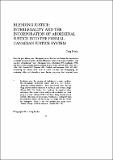|
Reseña:
|
Over the past fifteen years Aboriginal justice discourse in Canada has focused on seemingly incommensurable cultural differences between the legal sensibilities and practices of traditional1 ‘new’ Aboriginal justice (Boutelier 1996; LaPrairie 1998) and those of the Canadian formal criminal justice system (RCAP 1996, 1993; Ross 1996, 1992; Proulx 1997; Dumont 1993; Griffiths and Patenaude 1988; AJI 1991). Countering the culture clash view of crime causation and downplaying the continuing effects of colonialism were theories proposing that structural socio- economic inequities in Canadian society were responsible for overrepresentation(LaPrairie 1998, 1995; Depew 1996). A third theoretical strain maintained that thelegacy of historical wrongs should not be downplayed suggesting that thecontinuing mind-set of colonialism fostered socio-economic inequities leading tooverrepresentation (Proulx 2003, 2000). Aboriginal justice discourse mainlyfocused upon efforts to provide culturally sensitive justice programmingalternatives for Aboriginal peoples in order to reduce overrepresentation.Evaluation of this programming was and is a concern (Proulx 2003, 2000, 1997;Depew 1996; LaPrairie 1998, 1995; Clairmont and Linden 1997). Additionally,urban Aboriginal justice programming was rarely initiated and was underresearched in comparison to rural and reserve initiatives (Proulx 2003). Efforts were also expended to define, problematize and operationalize ‘the community’ as the site and delivery system for new Aboriginal justice (Proulx 2003; Andersen 1999; LaPrairie 1998; Depew 1996). Gender discrimination within Aboriginal ‘traditional’ justice initiatives was and is a significant theme. Concerns have been raised about male domination of new Aboriginal justice and the re-victimization of Aboriginal women in Aboriginal justice programs (LaRocque 1997; Crnkovich 1996). Interestingly, however, little attention has been paid to how new Aboriginal justice has affected non-Aboriginal justice philosophy and practice. |

